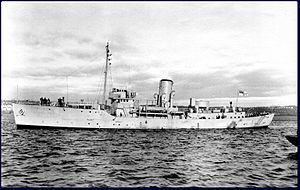Name Windflower Ordered 22 January 1940 Commissioned 20 October 1940 Construction started 25 February 1940 Length 62 m | Namesake Windflower Laid down 25 February 1940 Out of service 15 May 1941 Launched 4 July 1940 Draft 3.51 m | |
 | ||
HMCS Windflower was a Royal Canadian Navy Flower-class corvette which took part in convoy escort duties in the Battle of the Atlantic during the Second World War.
Contents
Background
Flower-class corvettes like Windflower serving with the Royal Canadian Navy during the Second World War were different from earlier and more traditional sail-driven corvettes. The "corvette" designation was created by the French as a class of small warships; the Royal Navy borrowed the term for a period but discontinued its use in 1877. During the hurried preparations for war in the late 1930s, Winston Churchill reactivated the corvette class, needing a name for smaller ships used in an escort capacity, in this case based on a whaling ship design. The generic name "flower" was used to designate the class of these ships, which – in the Royal Navy – were named after flowering plants.
Construction
Windflower was ordered on 22 January 1940 as part of the 1939-1940 Flower-class building program and laid down at George T. Davie & Sons Ltd., Lauzon on 24 February 1940. Launched on 8 August 1940 she was commissioned into the Royal Navy on 20 October. She was among the ten corvettes to be transferred to the RCN and commissioned on 15 May 1941. She could be told apart from other Canadian Flowers by her lack of minesweeping gear and the siting of the after gun tub amidships.
Service with Royal Navy
After working up at Tobermory Windflower was assigned to Escort Group 4 with the Royal Navy escorting convoys between the United Kingdom and Iceland.
Service with Royal Canadian Navy
After she was loaned to the Royal Canadian Navy Windflower transferred to Newfoundland Command after completing the voyage with OB 332. She made three round trips from St. John's to Iceland only interrupted by a short refit at Liverpool, Nova Scotia from August to mid-October.
Sinking
On 7 December 1941, Windflower was escorting Convoy SC.58 when she collided with Dutch merchant Zypenberg in dense fog on the Grand Banks at 46° 19N, 49° 30W. 23 crew were lost. At the time corvettes were not outfitted with radar.
